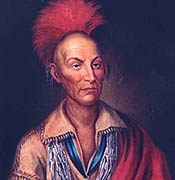Saux Indian (1767-1838)

In 1804, representatives of the Saux and Fox tribes were called to St. Louis where federal agents secured an agreement to a treaty ceding all tribal lands east of the Mississippi. The tribal leaders had been deceived through trickery, bibery or even threats into signing a treaty that they didn’t understand . The tribes were then forced out of their homes, to the other side of the river where they lived a meager existence for three years.
In the Spring of 1831, a 50-year old warrior named Black Hawk led his people back across the river to their village of Saukenuk to plant crops. He was appalled at what he found there. Whites had moved into the abandoned Sauk lodges and had fenced in the cornfields and were plowing right up to his ancestor’s graves. “My reason tells me that land cannot be sold – nothing can be sold but such things as can be carried away.” – Black Hawk.
With that, Black Hawk and 300 of his warriors settled in for the summer, refusing to budge. A year later his band was 600 strong and the federal government took notice of his brazen defiance by sending out a large militia force. The militia arrived in May of 1832 and Black Hawk tried to settle the matter peacefully, under a flag of truce. Jittery militiamen opened fire and this started the Black Hawk war.
In the first skirmish, 40 Sauk warriors repelled 275 militiamen. Over the next three months, Black Hawk had several thousand federal and state troops to contend with. The forces chased Black Hawk and his people north across Illinois and Wisconsin. Whites fell ill with cholera and the Sauk, traveling with women and children, with little time to hunt, suffered starvation and fatigue.
In August, Black Hawk and his people arrived at the Bad Axe River in Wisconsin where they hoped to build canoes and rafts and float downstream to the Mississippi River and then on to safety. The next day, they were met with a U.S. gunship filled with troops. And again, Black Hawk raised his flag of truce. He was immediately fired upon and 23 of his men fell dead. The following morning, 1,300 troops swept through the Indian encampment, firing wildly at men, women and children. As many as 300 Sauk were killed. Black Hawk led the survivors north to seek refuge with the Winnebago who later betrayed him to white authorities for $100 and 20 horses.
“You have taken me prisoner with all my warriors. I am much grieved…I expected to hold out much longer and give you more trouble before I surrendered. Black Hawk is now a prisoner of the white man. But he can stand torture, and he is not afraid of death. He is no coward. Black Hawk is an Indian.” – Black Hawk.
Black Hawk died in 1838 and his remains were eventually placed in the Burlington Historical Society in Illinois. But the building burned down in 1855 and his remains were forever lost.





